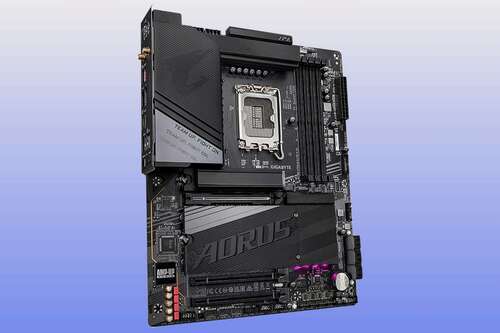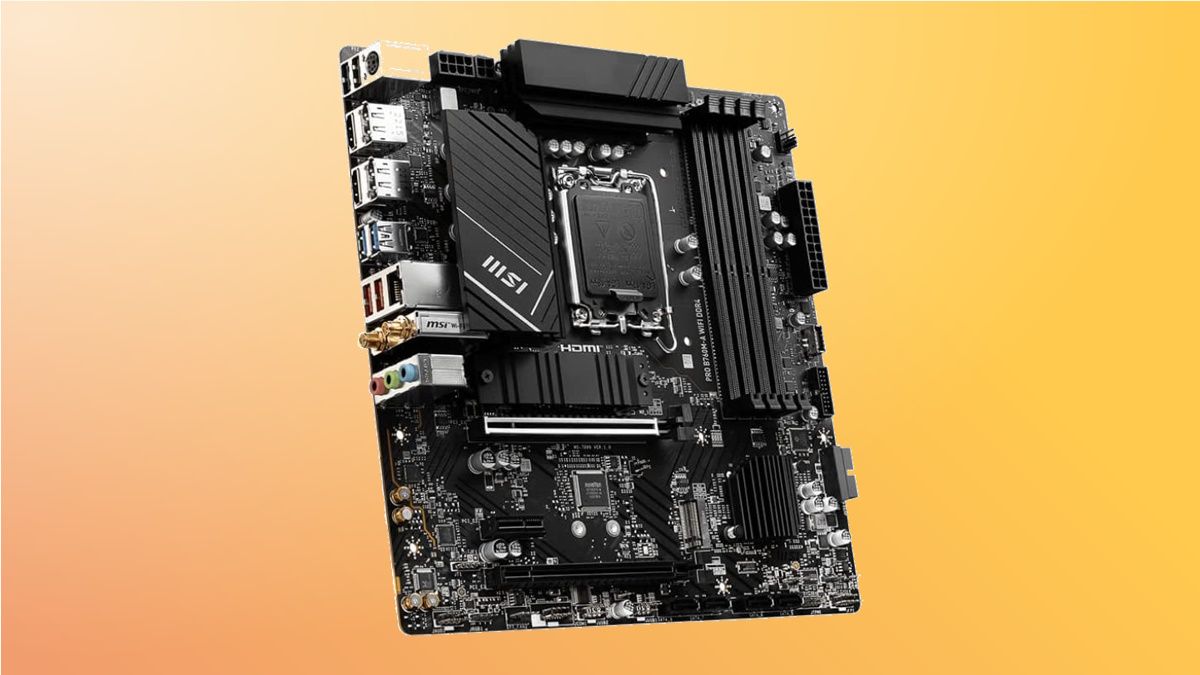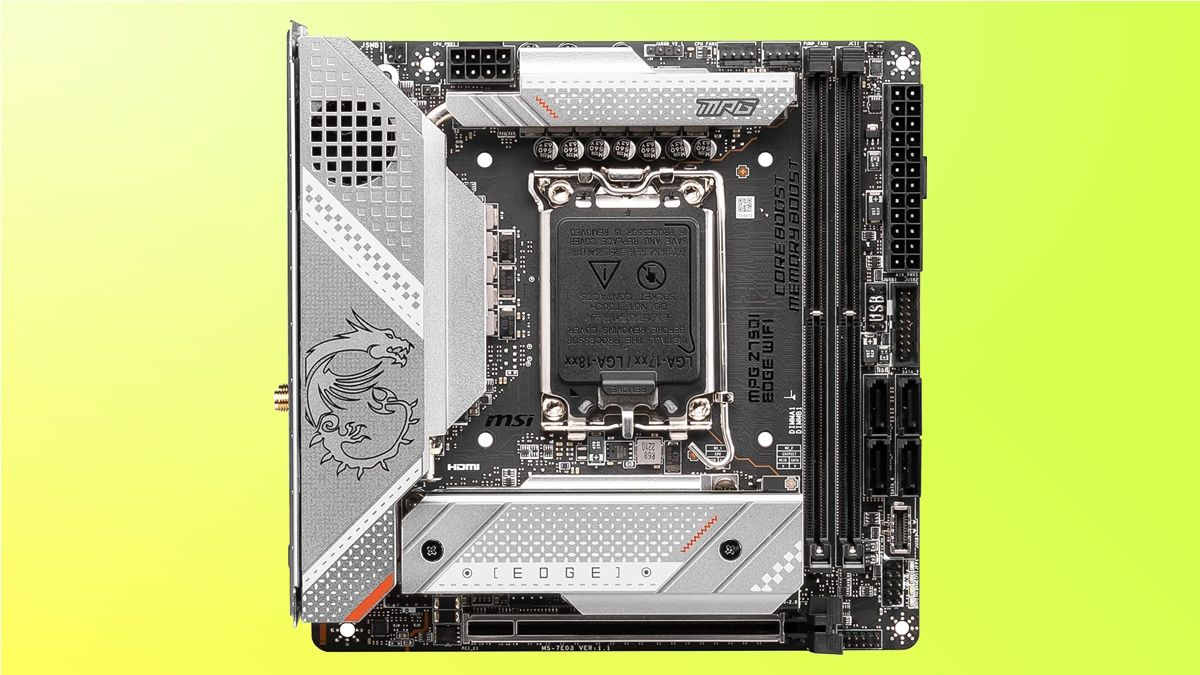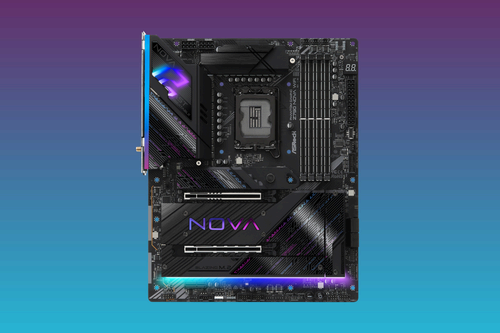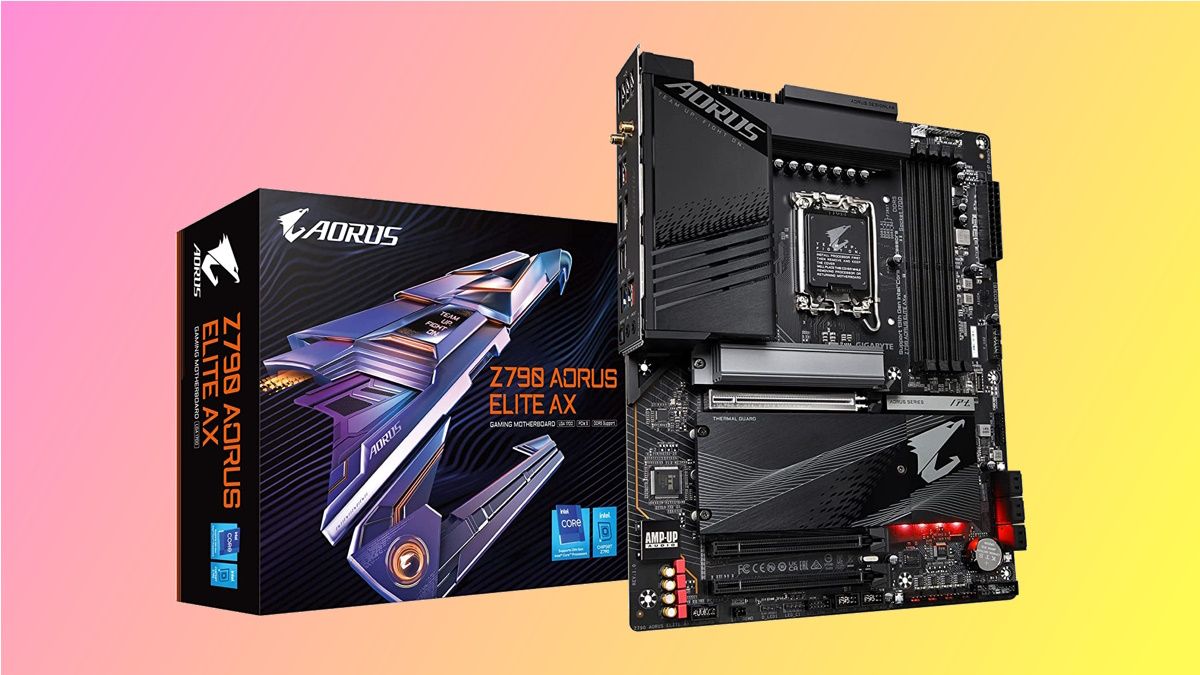Have an Intel CPU? You’ll need a quality motherboard that’s compatible with it. The motherboard is essentially the central nervous system of every PC, and the right one will make sure your rig will work flawlessly without overworking the other components.
UPDATE: 01/08/2024
We’ve reviewed our recommendations and updated our choices for the best overall and best DDR5 Intel motherboards.
What to Look For in an Intel Gaming Motherboard in 2024
First, you should consider whether the board you’re eyeing is compatible with your CPU. In other words, its chipset and the CPU socket must be compatible with the processor you plan on buying.
After you find out your CPU’s socket and the chipsets your processor is compatible with, it’s time to focus on motherboard features. The most important feature of every board is its voltage-regulating module (VRM), which keeps the voltage supplied to your CPU consistent.
If you get a board with a low-quality VRM, said motherboard won’t be able to run your CPU at its max power and performance, which can leave a lot of gaming performance on the table.
Next, focus on expansion ports, connectivity, and storage support. You should find a board that hits all the boxes regarding your needs and then some, so you have enough storage support to add more SSDs or HDDs, hook up more case fans, and have enough USB ports for any new peripherals you might add in the future.
For instance, while multi-GPU gaming is dead and gone, you might want to pick a board with multiple high-bandwidth PCIe x16 slots—like dual PCIe 5.0 x16 slots that can work in x8/x8 mode along with another PCIe 4.0 x4 slot—in case you want to add a capture card, an adapter allowing you to install more NVMe SSDs, or a beefy 10Gbps network card in case you rock a network attached storage (NAS).
Similarly, extra features such as the ability to update BIOS without a CPU, or diagnostic LEDs that can quickly identify the source of the issue you’re having, can be handy if you’re running into issues.
Also, a 2.5Gbps LAN (RJ-45) port and a quality Wi-Fi solution are always good to maximize your internet bandwidth or if you upgrade your internet plan in the future. On the other hand, if you need a 10Gbps LAN port, it’s better to get a 10Gbps LAN PCIe card instead of spending hundreds of dollars more on a high-end motherboard rocking a 10Gbps LAN port.
Concerning audio, you should know that even basic audio chips these days are good enough for most users. Beefier boards usually do a better job isolating audio-related components than affordable models, resulting in a clearer audio signal instead of packing enthusiast-grade hardware.
Many affordable DACs are better than most onboard audio solutions anyway. You can upgrade your sound experience with a quality yet affordable DAC and spend way less than getting a high-end board featuring a high-end audio solution.
When it comes to the form factor, there are loads of excellent ATX gaming motherboards for your Intel CPU. The mATX or micro ATX form factor isn’t as popular, but you can find a few quality models. SFX aficionados are limited to a couple of high-end models if you’ve picked a K-series CPU and one or two budget mini-ITX boards, mostly from ASRock, in case you’ve bought a non-K Intel CPU.
Before we move on to our first pick, it’s worth pointing out that most Intel motherboards featuring a PCIe 5.0 M.2 slot halve the bandwidth to the primary PCIe x16 slot from x16 to x8 if you install an SSD into the said PCIe Gen5 slot.
Also, note that if you own a 600 or 700 series motherboard—Z690, B660, H670, Z790, B760, H770, etc.—the board should work with a 14th gen Intel CPU. Some boards will work fine without a BIOS update, while others will need one to boot with a 14th-gen CPU in their socket. If your motherboard has a BIOS flash button, you can install the needed update without a CPU. But if it doesn’t, you’ll need to install the update with your current CPU installed before dropping the new 14th-generation processor inside the socket.
|
How Did We Research |
||
|
Models Evaluated |
Hours Researched |
Reviews Analyzed |
|
32 |
10 |
24 |
How-To Geek’s product recommendations come from the same team of experts that have helped people fix their gadgets over one billion times. We only recommend the best products based on our research and expertise. We never accept payment to endorse or review a product. Read More »
|
Pros |
Cons |
|---|---|
|
Lots of features |
Could be more affordable |
|
Excellent connectivity options |
The BIOS Flashback and clear CMOS buttons are located on the board rather than on the rear I/O |
|
Four M.2 slots and toolless M.2 slot design |
|
|
Supports BIOS Q-Flash |
|
|
Richly populated rear I/O panel |
|
|
High-quality VRM |
The GIGABYTE Z790 AORUS ELITE X AX is a mid-range motherboard with out-of-the-box support for 14th gen Intel CPUs that packs everything you might need as long as the list of features you want doesn’t include things like 40Gbps USB connectivity, five or more M.2 slots, or a high-end audio section.
The board can host up to four RAM sticks and can work with up to 192GB of 8266 MT/s DDR5 memory. The primary PCIe x16 slot is Gen5, with the other two PCIe slots supporting the PCIe 4.0 standard and working at x4 speeds. That’s enough for a capture card, a high-end sound card, a LAN expansion card, or any other PCIe expansion card you might want to install.
Storage support is excellent for a mid-range offering. There are six SATA III ports along with four M.2 PCIe 4.0 x4 slots, which should be enough for even the most demanding users. Connectivity-wise, you’ve got a 2.5Gbps LAN port and a Wi-Fi 6E card that also includes Bluetooth 5.3 support.
The rear I/O includes one USB-C 3.2 20Gbps port, two USB-A 3.2 10Gbps ports, three USB-A 3.2 5Gbps ports, and four USB 2.0 ports. The rear I/O panel also hosts a single LAN port, one HDMI, and one DisplayPort connector for the iGPU, two audio jacks, and an optical S/PDIF Out connector. Overall, a pretty solid showing for a mid-ranger.
As for the audio section, you’ve got the Realtek ALC1220-VB codec at its heart, with support for 5.1 and 7.1-channel setups. Other features worth mentioning include an internal USB-C 3.2 10Gbps front header, a toolless M.2 slot design allowing you to easily install and swap NVMe SSDs, three ARGB headers, and five fan headers in total, two of which can be used for water cooling pumps.
While the Z790 AORUS ELITE X AX features both a BIOS flash and a clear CMOS button, the two buttons are placed on the board itself and aren’t as easily accessible as they would’ve been if Gigabyte decided to put them on the rear I/O panel.
If you don’t plan to get a 14th gen Intel CPU for your next gaming PC, you can get the more affordable Gigabyte Z790 Aorus Elite AX instead, which is virtually the same product, albeit without out-of-the-box 14th gen support and with a slightly inferior audio solution.
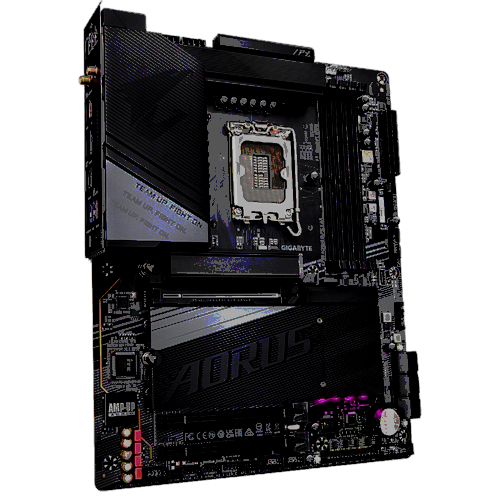

Gigabyte Z790 AORUS Elite X AX
Best Intel Motherboard for Gaming Overall
$270 $290 Save $20
If you’re after a well-rounded and feature-rich mid-range Z790 offering capable of running any 13th or 14th gen Intel CPU without breaking a sweat, take a look at the GIGABYTE Z790 AORUS Elite X AX.
|
Pros |
Cons |
|---|---|
|
Excellent VRM |
Lacks the BIOS flashback button |
|
Wi-Fi 6E and 2.5Gbps LAN |
Missing I/O shield |
|
Attractive Design |
No USB-C ports on the rear I/O |
|
Compact form factor |
|
|
Multiple M.2 ports with PCIe 4.0 NVMe SSD support |
|
|
Competitive price |
If you’re on a budget, we’d recommend the MSI PRO B760M-A Wi-Fi DDR4. This motherboard has the best VRM on the budget Intel motherboard market. You can slap the Intel Core i9-13000K on it, and the CPU will reach its full potential as long as you have a good enough cooling solution.
The specs here aren’t great, but we couldn’t ask for more since this is a budget Intel motherboard. You’ve got two M.2 slots supporting PCIe 4.0 NVMe SSDs, one PCIe 4.0 x16 slot, one PCIe 4.0 x16 slot working in x4 mode, and one PCIe 3.0 x1 slot.
The board also comes with four SATA III ports, 2.5Gbps LAN, and Wi-Fi 6E support, and its audio section is based on the Realtek ALC897 audio codec. If you want the best audio quality, however, you’ll have to get a separate DAC. The rear I/O features two USB-A 10Gbps ports, two USB-A 5Gbps ports, and two USB 2.0 ports. There are also two HDMI and two DisplayPort connectors.
The good news is that the MSI PRO B760M-A Wi-Fi DDR4 has an internal USB-C connector in case your PC enclosure features a front USB-C port, but it’s a USB-C 5Gbps connector instead of a USB-C 10Gbps. You’ve also got four debug LEDs, which can help troubleshoot hardware issues. Downsides here include the lack of a BIOS flash button, no I/O shield, and no USB-C ports on the rear I/O panel. However, considering the price, we can’t complain.
Those who want DDR5 support can get the MSI MAG B760M MORTAR Wi-Fi, which also falls in this price range.
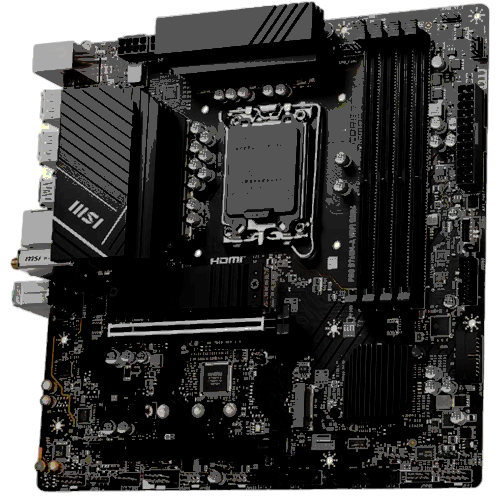

MSI PRO B760M-A WiFi DDR4
Best Budget Intel Motherboard for Gaming
The MSI PRO B760M-A WiFi DDR4 is one of the best budget motherboards for Intel CPUs on the market thanks to its high-end VRM, compact design, multiple PCIe 4.0 M.2 slots, and excellent connectivity options. It has some downsides, but you’ll hardly get a better package at this price.
|
Pros |
Cons |
|---|---|
|
High-end VRM for a Mini-ITX motherboard |
Lacks Thunderbolt 4 ports |
|
Three M.2 slots |
|
|
Wi-Fi 6E and 2.5Gbps LAN |
|
|
Excellent price |
|
|
High-quality audio |
The best Mini-ITX Intel motherboard for gaming is the MSI MPG Z790I Edge Wi-Fi. MSI knocked it out of the park with this board, considering that it offers a ton of features at an excellent price point for a high-end Mini-ITX motherboard. You only need to worry about cooler compatibility; make sure you can mount the cooler you want before buying it or the board.
Specs-wise, you’ve got DDR5 memory support, a single PCIe 5.0 x16 slot, and three M.2 ports. Two can handle PCIe 4.0 NVMe SSDs, while the third supports PCIe 3.0 NVMe and SATA SSDs. We are delighted to see three M.2 slots on an ITX motherboard since most ITX designs pack only two M.2 slots. The VRM here can handle the Intel Core i9-13900K without issues, just don’t try to overclock it.
The goodies continue with Wi-Fi 6E, Bluetooth 5.2, and a 2.5Gbps LAN. The Realtek ALC4080 audio codec that powers the audio section is the cherry on top. The ALC4080 is an excellent built-in audio solution for mid-range and high-end motherboards.
The rear I/O features four USB-A 10Gbps ports, four USB-A 5Gbps ports, a single HDMI, a single DisplayPort connector, and a BIOS flash button. No USB-C or Thunderbolt 4 ports here, a notable omission. Luckily, you’ve got an internal USB-C 20Gbps header, which softens the blow somewhat.
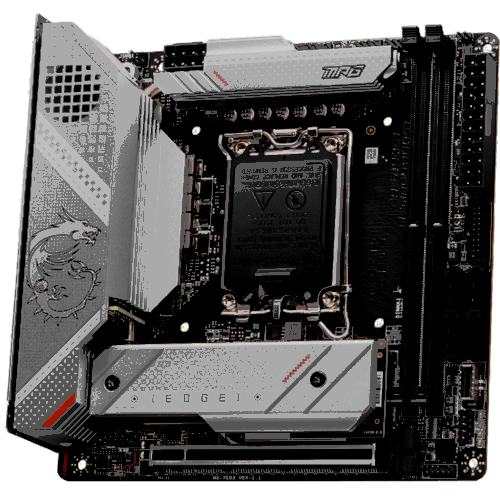

MSI MPG Z790I Edge WiFi
Best Mini-ITX Intel Motherboard for Gaming
$310 $360 Save $50
The MSI MPG Z790I Edge WiFi is a brilliant Mini-ITX Intel motherboard for gaming that packs three M.2 slots and a high-end VRM. The board lacks Thunderbolt 4 ports on the rear I/O, but that’s about the only major negative we can find.
|
Pros |
Cons |
|---|---|
|
Ravishing looks |
Lacks a 10Gbps LAN port |
|
High-end VRM |
Has zero USB4 or Thunderbolt 4 ports |
|
Wi-Fi 7 |
|
|
Six M.2 slots in total with toolless design |
|
|
POST code display |
|
|
Striking RGB implementation |
The ASRock Z790 Nova Wi-Fi is yet another Z790 refresh motherboard that supports 14th-gen Intel CPUs out of the box. The board’s main selling points, aside from the native support for 14th gen processors, include Wi-Fi 7, six M.2 sockets, a high-end 8-layer printed circuit board (PCB), and a VRM setup capable of running any 14th gen Intel CPU without power limits.
Another selling point is the striking design, which incorporates a ton of cool-looking RGB and plenty of heatsinks and heat shields, making the Z790 Nova WiFi arguably the best-looking Z790 motherboard on the market.
Out of the six M.2 sockets, the primary is a PCIe Gen5x4, with the rest being Gen4x4. The motherboard also includes four SATA III ports. While it’s not the six or eight you’d get with most other options at this price point, having six M.2 slots is much better than six or eight SATA III ports in this day and age.
The primary PCIe x16 slot is armored and works at full x16 bandwidth. The secondary PCIe x16 slot is a Gen4x4 and should work fine with most expansion cards. The board also houses a single PCIe 3.0 x1 slot.
Connectivity options include a 2.5Gbps LAN along with the aforementioned Wi-Fi 7 chip. The wireless chip also supports Bluetooth 5.4. The four DIMM slots can host up to 192GB of RAM working at up to 7800 MT/s in dual channel mode. As for the audio section, you’ve got the Realtek ALC4082 codec at its heart, which is a solid option at this price point.
The rear I/O hosts one USB-C 3.2 20Gbps port, four USB-A 3.2 10Gbps ports, three USB 3.2 5Gbps ports, and two USB 2.0 ports. Pretty good coverage, but the lack of 40Gbps USB4 or Thunderbolt 4 ports is disappointing. The rear panel also includes a clear CMOS button, two audio jacks, one optical S/PDIF connector, and an HDMI and DisplayPort combo for the iGPU.
The ASRock Z790 Nova WiFi comes with a toolless M.2 design, meaning that you can install and remove NVMe SSDs without a screwdriver. Concerning internal connectors, you’ve got one RGB header, three ARGB headers, seven fan headers that are compatible with water pumps, a single VRM fan header, and a USB-C 20Gbps front panel connector.
You’ve also got a POST code display to ease troubleshooting, as well as power and reset buttons found at the bottom of the PCB. No BIOS flash button here, which is understandable considering that the Z790 chipset won’t support future Intel CPUs.
The main downside of the ASRock Z790 Nova WiFi is the lack of even a single USB4 or Thunderbolt 4 port with 40Gbps bandwidth. If you need 40Gbps USB connectivity, we recommend getting the ASUS ROG Maximus Z790 Hero. This board comes with two Thunderbolt 4 ports and an equally impressive RGB setup, but it’s far more expensive than ASRock’s offering and comes with five M.2 slots instead of the six found on the ASRock Z790 Nova Wi-Fi.
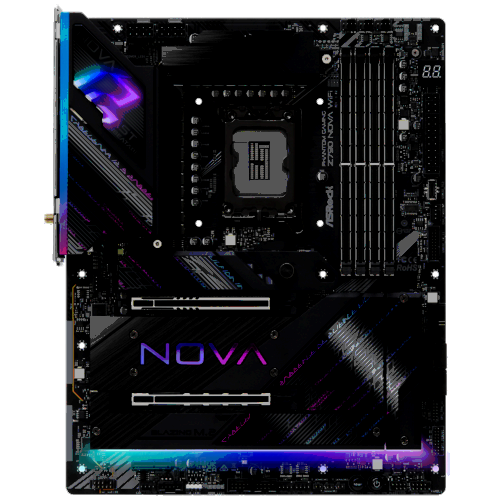

ASRock Z790 Nova WiFi
Best DDR5 Intel Motherboard for Gaming
If you’re after ravishing looks but also need lots of M.2 slots, high-end VRM, out-of-the-box support for 14th gen Intel CPUs, and speedy wireless connectivity, the ASRock Z790 Nova WiFi is one of the best choices on the market.
|
Pros |
Cons |
|---|---|
|
The best VRM you can find in a motherboard compatible with Intel CPUs |
Very Expensive |
|
Four M.2 slots |
Lacks Thunderbolt 4 ports |
|
Wi-Fi 6E |
Comes without a 10Gbps LAN port |
|
BIOS flashback button |
|
|
Lots of OC-friendly features |
|
|
High-end audio solution |
The Gigabyte Z790 Aorus Tachyon is a beastly motherboard made for overclocking that broke several Intel CPU and RAM OC records. If you’re looking for an Intel-compatible gaming motherboard made for overclocking the memory and the CPU, this is the board to get. This is an Extended-ATX (E-ATX) board, meaning it’s wider than a regular ATX motherboard. Make sure it can fit inside your case before pulling the trigger.
The Z790 Aorus Tachyon features only two RAM slots because you can get better results when overclocking your memory. The overkill VRM unit is here to ensure the best CPU OC results. Other specs include four M.2 connectors, all four with PCIe 4.0 NVMe SSD support, four SATA III ports, one PCIe 5.0 x16 slot, one PCIe 5.0 x16 slot working in x8 mode, and one PCIe 3.0 x16 slot running at x4.
Connectivity options include a single 2.5Gbps LAN port, Wi-Fi 6E by Intel, and Bluetooth 5.3. The rear I/O hosts one USB-C 20Gbps port, three USB-A 10Gbps ports, and four USB-A 5Gbps ports. The rear I/O includes a BIOS flash, clear CMOS buttons, and a single HDMI port.
The lack of Thunderbolt 4 here is a major downside. Yes, this is a motherboard made for OC, but still, considering the price, we’d expect at least a single Thunderbolt 4 port on its rear. The Realtek ALC1220-VB Codec powers the audio section. It’s not the best solution but good enough for most users, especially those focused on overclocking their CPU.
If you’re looking for a flagship Intel motherboard for gaming that costs less, comes with more features, has lots of RGB, and can still net you pretty good overclocking results, we recommend the Gigabyte Z790 AORUS XTREME. This flagship Intel motherboard has multiple Thunderbolt 4 ports, 10Gbps LAN, and a higher quality audio section, but a lower OC potential than the Z790 Aorus Tachyon.
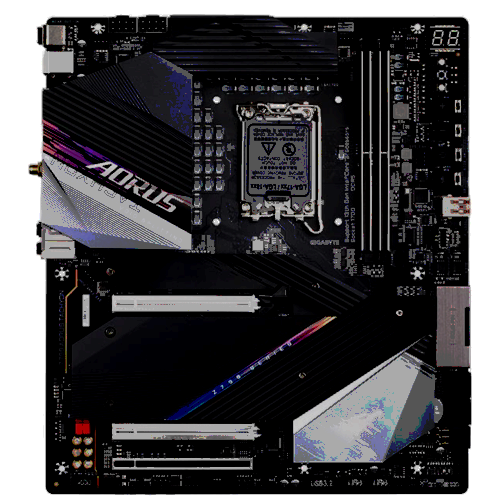

Gigabyte Z790 AORUS Tachyon
Best Intel Motherboard for Overclocking
The Gigabyte Z790 AORUS Tachyon is the best Intel motherboard for overclocking you can get. It’s equipped with plenty of OC-friendly features, but it also lacks some features you’d expect in a flagship motherboard, such as Thunderbolt 4 ports, 10Gbps LAN, or four RAM slots.
FAQ
What is the difference between an Intel and AMD motherboard?
The two main differences are CPU sockets and chipsets. Intel and AMD processors use different CPU sockets and are compatible with different chipsets used to control the flow of data between the CPU, GPU, memory, and other components in your PC.Note that different generations of Intel and AMD CPUs use different CPU sockets and are compatible with different chipsets. For instance, the Intel Core i9-13900K is only compatible with motherboards rocking the LGA 1700 CPU socket and one of the chipsets made for 12th and 13th-gen Intel CPUs, which include the following chipsets: W680, Q670, B660, H610, H670, Z690, B760, H770, W790, and Z790.
How do I check which motherboard I have?
You can take a look at the motherboard itself, check the box your motherboard came in, read the documentation available in the box, or check the model by using one of the tools available in your operating system.You can read our guide on how to check your motherboard model number on your Windows PC for a complete list of software-based ways to find out what motherboard you have in case you’re using Windows.
How do I update my motherboard BIOS?
To update your motherboard BIOS either download the BIOS file for your motherboard model, copy it to a USB thumb drive, and perform the update while in BIOS or use the BIOS flashback feature in case your board supports it. For a detailed explanation, read our guide on how to check your BIOS version and update it.
How do I test my motherboard?
To test your motherboard before installing it inside your case, place it on the top of the box it came in, connect the necessary power supply cables, install the RAM, CPU, and GPU, and mount the CPU cooler.Then, turn on the system, and if you see the post screen that shows you how to enter the BIOS menu, followed by a black screen with a notification that reads something like “Operating System not found,” you’re good to go.For a detailed step-by-step guide, watch Britec09 YouTube channel has an excellent and informative guide on how to test a new motherboard.
What is TPM on a motherboard?
TPM, or “Trusted Platform Module,” is a chip found on your motherboard used for disk encryption. If you want to install Windows 11, you’ll need TPM 2.0 on your motherboard. Most motherboards made in the last 6-7 years should feature TMP 2.0.To find out more, read our TPM explanation piece. To learn how to enable TPM 2.0, visit Microsoft’s guide on enabling TPM 2.0 on your PC.
